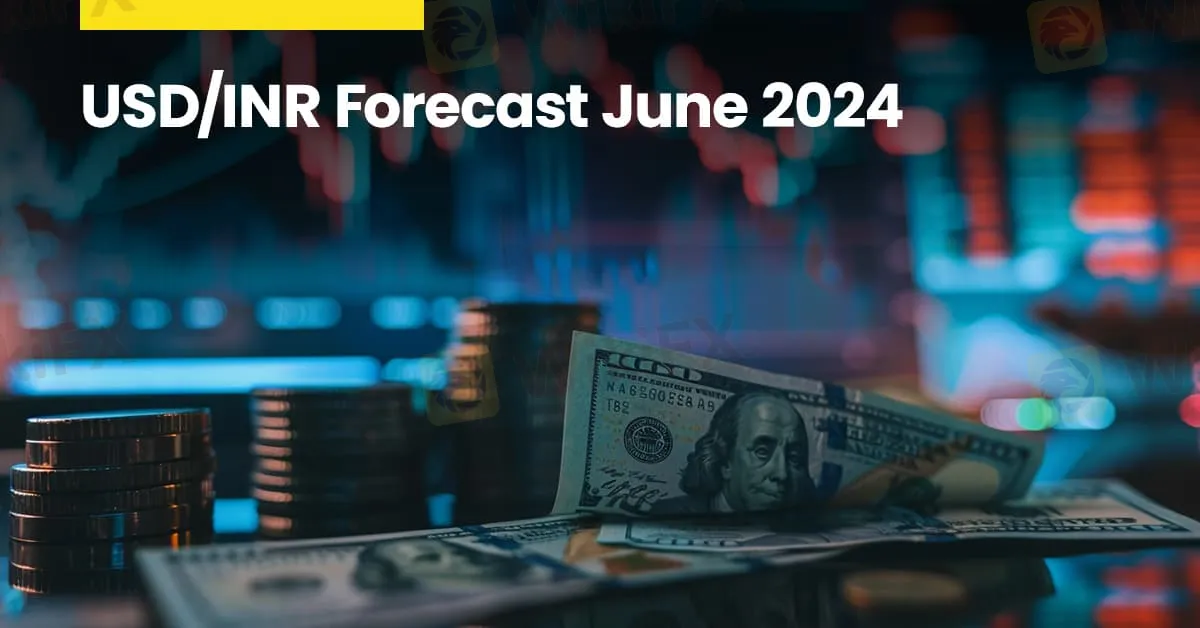简体中文
繁體中文
English
Pусский
日本語
ภาษาไทย
Tiếng Việt
Bahasa Indonesia
Español
हिन्दी
Filippiiniläinen
Français
Deutsch
Português
Türkçe
한국어
العربية
USD/INR Forecast June 2024
Abstract:According to the reports, the first two and a half weeks of May saw the USD/INR currency pair confined to a notably tight trading range. The pair faced robust resistance around the 83.5240 level, though there were occasional deviations. However, on May 17th, the USD/INR broke through the support level at approximately 83.39, which had held since May 6th, leading to a dip towards 83.2388.

According to the reports, the first two and a half weeks of May saw the USD/INR currency pair confined to a notably tight trading range. The pair faced robust resistance around the 83.5240 level, though there were occasional deviations. However, on May 17th, the USD/INR broke through the support level at approximately 83.39, which had held since May 6th, leading to a dip towards 83.2388.
On May 20th, the USD/INR tested the 83.1812 level before reversing to reach a high of around 83.3670 on Tuesday. As June approached, the currency pair traded near the 83.3200 mark amidst increased activity.
Intriguing Movements and RBI Influence
Recently, the USD/INR has been trading rapidly with a wide range, indicating heavy trading volume. While questions about the Rupee being a free-floating currency persist, the broader Forex market has adjusted its outlook on the U.S. Federal Reserve, anticipating a more dovish stance in the mid-term.
The Reserve Bank of India (RBI) has closely monitored and controlled the USD/INR value. The recent dip in the currency pair over the past week and a half is noteworthy. On the previous Friday, a low of 82.9775 was recorded, and despite a slight rebound, the USD/INR hovered around the 83.0000 level on Monday. Yesterday saw an upward movement, indicating a bullish trend. However, speculators should exercise caution with risk management due to potential RBI intervention.
Political and Economic Factors Influencing USD/INR
The results of the Indian national election, expected on June 4th, will significantly impact trading perceptions. While preliminary results might be available on Tuesday, the final tally may take until June 5th. The outcome of the Lok Sabha elections will influence financial institutions' reactions. Traders should prepare for potential volatility in the USD/INR early next week, though the RBI is likely to prevent extreme volatility.
In addition to the election results, the U.S. will release important growth and inflation data later this week. Thursday's GDP results and Friday's inflation numbers will affect Forex market sentiment. The question remains whether the USD/INR will react to these developments within its established trading range.
USD/INR Outlook for June 2024
The speculative price range for the USD/INR in June 2024 is between 82.9300 and 83.5600. The forthcoming Indian election results will influence sentiment surrounding the USD/INR. A significant influx of opposition members in the Lok Sabha could mean the ruling government might need to adopt broader decision-making processes, which financial institutions might not view negatively.
Economic stability in India is crucial. The USD/INR has maintained a tight trading range compared to most other major currency pairs. A sudden shift to a fully floating USD/INR without potential RBI intervention is unlikely. Traders should continue to leverage technical support and resistance levels while exercising patience and utilizing take-profit and stop-loss orders to navigate this intriguing value range.
Understanding the Indian Rupee
The Indian Rupee, issued by the Reserve Bank of India (RBI), is India's official currency. It became the national currency in 1947, replacing the currencies of the previously autonomous states. Historically pegged to the British pound due to colonial ties, the Rupee was delinked from the pound in September 1975 as India's trade diversified.
The Rupee now operates under a free-floating exchange rate system influenced by market supply and demand. The RBI ensures stable conditions in the foreign exchange market by monitoring currency and financial market movements closely and intervening when necessary to maintain the Rupee's price stability.

Disclaimer:
The views in this article only represent the author's personal views, and do not constitute investment advice on this platform. This platform does not guarantee the accuracy, completeness and timeliness of the information in the article, and will not be liable for any loss caused by the use of or reliance on the information in the article.
Read more

WikiEXPO Dubai “Welcome Party” Concludes Successfully, Setting the Stage for the Main Event!
On the evening of November 10, 2025, the highly anticipated WikiEXPO Dubai “Welcome Party” was successfully held at the 6th Floor, Conrad Dubai, UAE. Serving as a “prelude” to the official opening of the expo, this event provided a high-end yet relaxed communication platform for representatives of global regulatory bodies, leaders of Fintech companies, renowned brokers, and senior executives of investment institutions.

VARIANSE Review: Traders Raise Deposit & Withdrawal Issues and High Commission & Swap Charges
Are you losing both while depositing and withdrawing your capital at VARIANSE? Does the broker give the currency conversion rate excuse for this? Have you been trapped with spreads charged higher than promised? Do you bear steep commission and swap charges at this broker? Traders frequently report these trading issues online. In today’s VARIANSE broker review, we have shared some trading complaints that have grabbed everyone’s attention. Take a look.

Zetradex Exposed: Withdrawal Denials, Account Freeze & Bonus Issues Hurt Traders
Do you constantly face withdrawal denials by Zetradex? Does the forex broker keep freezing your account and wiping out your capital? Have you also undergone issues concerning the Zetradex no deposit bonus? These trading issues have become apparent as the forex broker allegedly scams traders all over. In this Zetradex review article, we have demonstrated some complaints. Read them to get a feel of what happens to traders here.

Fullerton Markets Review: Traders Allege Profit Wipes and Illegitimate Withdrawal Rates
Have you witnessed constant profit deletion from Fullerton Markets? Has the Saint Vincent and the Grenadines-based forex broker wiped out all your capital after you checked it on Fullerton Markets Login? Do you find the deposit and withdrawal rates abnormal here? These complaints have been grabbing everyone’s attention on Fullerton Markets Review Platforms. In this article, we have shared some of these complaints for you to look at and inspect. Read on!
WikiFX Broker
Latest News
BASF CEO: EU CO₂ Trading Is A "Destruction Mechanism" For European Industry
Is Fyntura a Regulated Broker? A Complete 2025 Broker Review
PINAKINE Broker India Review 2025: A Complete Guide to Safety and Services
Is Inzo Broker Safe or a Scam? An Evidence-Based Analysis for Traders
Is Uniglobe Markets Legit? A 2025 Simple Guide to Its Safety, Services, and User Warnings
Is Forex Zone Trading Regulated and Licensed?
WikiEXPO Dubai 2025 “Welcome Party” Kicks Off Tonight!
He Trusted a WhatsApp Group and Lost RM659,000
Exness Restricted Countries List 2025 Explained
Zetradex Exposed: Withdrawal Denials, Account Freeze & Bonus Issues Hurt Traders
Currency Calculator



